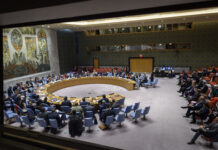Photo credit: DiasporaEngager (www.DiasporaEngager.com).
Although Russia has experienced attacks by ISIS and its affiliates before, the Crocus City Hall attack, claimed by ISIS-Khurasan, is one of the bloodiest terrorist attacks in Russia. It occurred during a complex and tense international strategic landscape marked by great powers’ geopolitical competition that confounded inferences about the attack, with Russia exploring links to its conflict in Ukraine and some Western commentators asserting ISIS-K’s fixation with Russia. Such a geopolitical fog, however, has overshadowed a growing reality: ISIS-K’s increasing capabilities to orchestrate attacks in different regions.
ISIS-K is an affiliate of ISIS that operates in South, Central, and Western Asia. The group was established in late 2014 in Northwest Pakistan, primarily consisting of Pakistani militants who were displaced from North Waziristan by the Pakistan Army’s military operation. Soon, the group pledged its loyalty to Abu Bakar Al-Baghdadi, then the leader of ISIS. In 2015, some Afghan Taliban commanders defected and joined ISIS-K, enabling the group to relocate to Eastern Afghanistan, where foreign militant groups such as the Islamic Movement of Uzbekistan (IMU) and the East Turkestan Islamic Movement (ETIM) joined forces with them, making the southern districts of Nangarhar province their stronghold.
In Afghanistan, the group’s composition changed into a multi-ethnic force with a mix of Pashtun militia from Afghanistan and Pakistan and Arab and Central Asian fighters. It developed a dual structure, with foreign elements as the core and local Pashtun militia as the protective outer layer. In 2020, ISIS-K suffered a strategic defeat at the hands of the U.S. military, Afghan government, and the then-Taliban insurgency, resulting in the group’s dispersal.
Following the defeat, ISIS-K’s foreign members relocated to the northern regions, while local militants were dispersed. Upon returning to power in 2021, the Taliban launched a brutal crackdown on the local Pashtun elements of ISIS-K, resulting in the deaths of thousands of individuals. Despite these actions, the Taliban regime denied the group’s presence in Afghanistan, and the location of the ISIS-K foreign elements has remained shrouded in secrecy.
ISIS-K’s Focus on Central Asia
ISIS-K is connected to Central Asia for various mythological, political, and pragmatic reasons. Its ideological inspirations to the region stem from the ancient “Khorasan Narrative,” which prophesizes the emergence of a group from the region with a black flag to join the Mahdi or messiah forces in Damascus for the final battle between the antichrist and the believers. In early and medieval Islamic history, this narrative has been used a number of times to justify political violence and revolts against the status quo. In the late twentieth century, the “Khorasan narrative” was revived by Abdullah Azzam, the founder ideologue of modern global jihad, during the Afghan-Soviet war in the 1980s and has since inspired modern global jihadists. ISIS adoption of its flag and the naming of its chapter in the Afghanistan-Pakistan region “Khurasan” served as a convenient recruitment tool for attracting fighters from Central Asian republics since 2013.
After the Cold War, the new Central Asian states became an attractive ground for radical Salafi ideology. The reinvention of cultural identity during the nation-building process led to increased religious education, which allowed outside groups to promote their radical ideologies among young men. State and non-state actors from Saudi Arabia, Iran, and Pakistan supported the establishment of new madrasas and imported radical Islamic literature, which influenced a new generation of pan-Islamists in the region.
As a result, Islamist militancy rose in Central Asia, exemplified by the Tajik insurgency in the 1990s and the establishment of the IMU and the ETIM. Subsequently, the ruling regimes’ political oppression, which involved restricting the peaceful practice of Islam and suppressing legitimate political opposition, fueled radicalism among the youth, making Central Asia a prime recruitment ground for Salafi jihadist groups in the 2000s. Thousands of combatants from the region joined Salafi groups in the Middle East, such as ISIS, the al-Nusra Front, and various al-Qaeda associates, making Central Asia the third most significant source of Salafi jihadist foreign fighters in the Middle East. After moving to the neighboring northern regions of Afghanistan, ISIS-K moved closer to a vast pool of potential recruits spanning across the borders.
Although some commentators believe the group singled out Russia due to its involvement in the Middle East, a more nuanced look suggests that the Moscow attack demonstrates the group’s growing capabilities. Since January this year, the group claimed attacks in different regions, including a shooting at a Roman Catholic Church in Istanbul, two bombings in Iran that killed over 100 and wounded scores, and a deadly attack on a private bank in Kandahar, the Taliban’s stronghold. Before the Crocus City Hall attack, two suspected members of ISIS-K were apprehended in Germany for plotting an attack on the Swedish Parliament.
These incidents serve as evidence of the organization’s increasing proficiency in executing operations in diverse regions. In recognition of ISIS-K’s expanding capabilities, General Michael Kurilla, head of the United States Central Command, testified before the House Armed Services Committee that, from its base in Afghanistan, ISIS-K persists in expanding and rebuilding its networks, enabling it to launch attacks from numerous nodes, including Russia.
Russia as a Target of ISIS-K
Russia has been dealing with Islamic terrorism since the early 2000s conflicts in Dagestan, Ingushetia, and Chechnya. In recent years, ISIS-K has conducted various operations against Russian targets, such as the 2017 bombing of the St. Petersburg metro and the 2022 attack on the Russian embassy in Kabul. The Crocus City Hall attack, however, stands as the most gruesome.
Russia has a number of attractive characteristics to jihadi terrorism. Russia’s direct military participation in the Syrian civil war has brought it into a direct confrontation with ISIS. Additionally, Russia’s role as a security player in Central Asia presents a challenge for ISIS-K, who seek to penetrate the region and realize their mythological “Khorasan narrative.” Although ISIS-K has recruitment potential in the area and is at the doorstep of Central Asia, Russia’s involvement as a security hegemon to protect its southern protective buffer may make it a prime target for the organization. However, with ISIS leadership dismantled and ISIS-K’s structure largely reduced, its main objective is to confirm its existence by plotting attacks wherever possible, rather than having clear, goal-oriented targets.
Moreover, Russia is not explicitly singled out as a target in ISIS-K’s online materials. Instead, the group tends to discuss Russia within the larger global context, frequently mentioning it alongside other major powers such as the United States, China, India, Britain, France, and Israel. Rather than having a focused strategic approach against Russia, ISIS-K appears to adopt a pragmatic and opportunistic approach, capitalizing on the presence of jihadist elements in the Caucasus, its proximity to Russia, and the prevalence of the Russian language in the area.
Geopolitics and Jihadi Terrorism
The renewed age of geostrategic competition is a sanguine development for the resurgence of global terrorism. It wreaks fragmentation and breakdown of global consensus and trust around counterterrorism efforts. With the emergence of new strategic imperatives, the focus on terrorism slips through the cracks, as happened in Moscow.
Although terrorist groups may have suffered strategic losses, such as leadership and core capabilities, their resolve and ability to reconvene seem more viable than ever before. The war in the Middle East and the contentious geostrategic standoff between major powers offers jihadi terrorist groups the opportunity and breathing room to plot their resurgence, as ISIS-K revealed in recent months.
Furthermore, the rise of the Taliban to power in Kabul has crucial significance for the resurgence of jihadi terrorist networks, including ISIS, al-Qaeda, and their affiliates. Although initial contact between the al-Qaeda core and the Taliban in Kabul has been reported, ISIS-K is expanding. With the Taliban promoting jihadi culture through mass media, including revering suicide bombings, a new wave of terrorism in the region has already set off in an international milieu defined by great powers’ geopolitical confrontation and reduced anti-terrorism coordination.
In the last two decades, counterterrorism was one of the limited policy issues that major powers converged around despite their divergent broader strategic interests. Such a consensus is unlikely to survive the ongoing geopolitical conflict of these powers. Amid such a colossal shift in international politics, jihadi terrorism, unlike ever before, will find more space and reasons to revive and spread. The resurgence of ISIS-K points to such a transformation in the global jihadi landscape.
Source of original article: Foreign Policy In Focus (fpif.org).
The content of this article does not necessarily reflect the views or opinion of Global Diaspora News (www.GlobalDiasporaNews.com).
To submit your press release: (https://www.GlobalDiasporaNews.com/pr).
To advertise on Global Diaspora News: (www.GlobalDiasporaNews.com/ads).
Sign up to Global Diaspora News newsletter (https://www.GlobalDiasporaNews.com/newsletter/) to start receiving updates and opportunities directly in your email inbox for free.
































